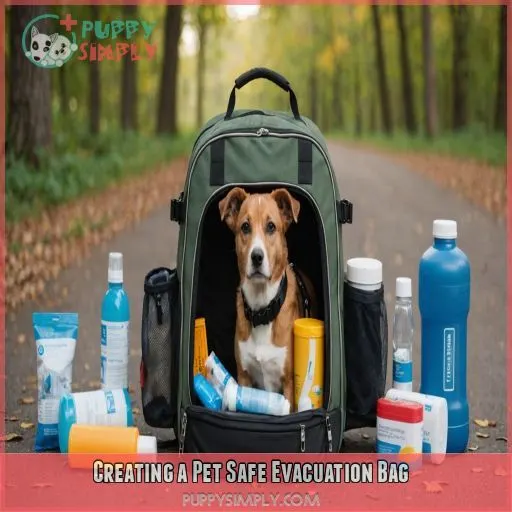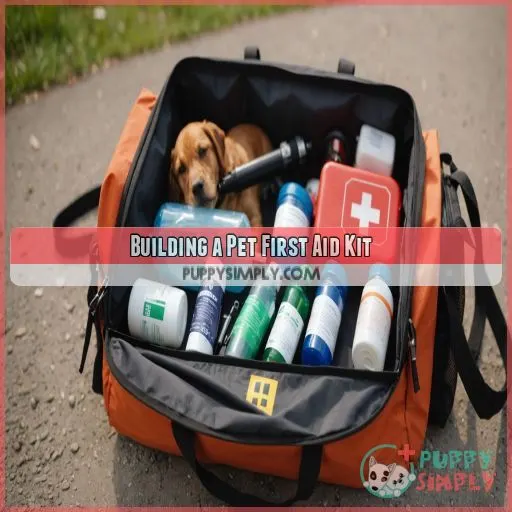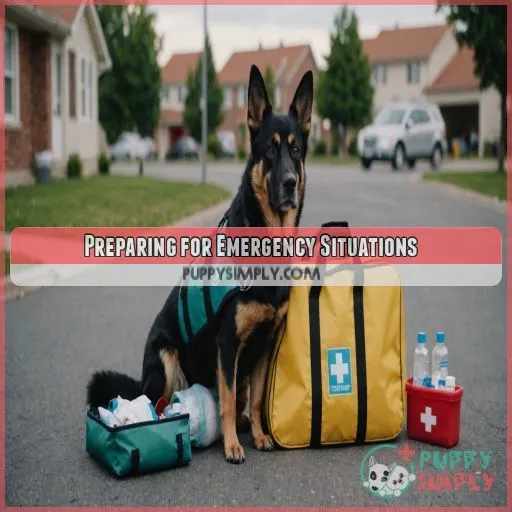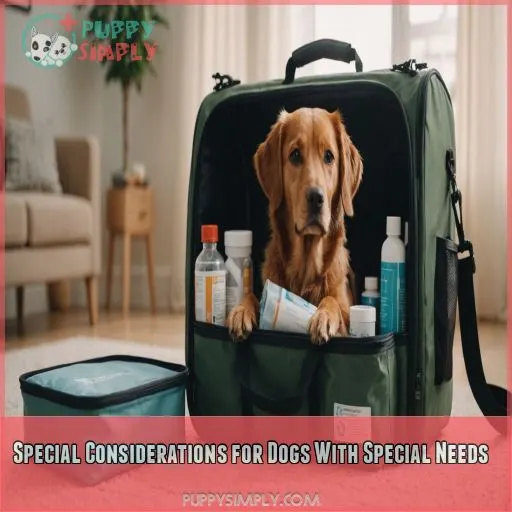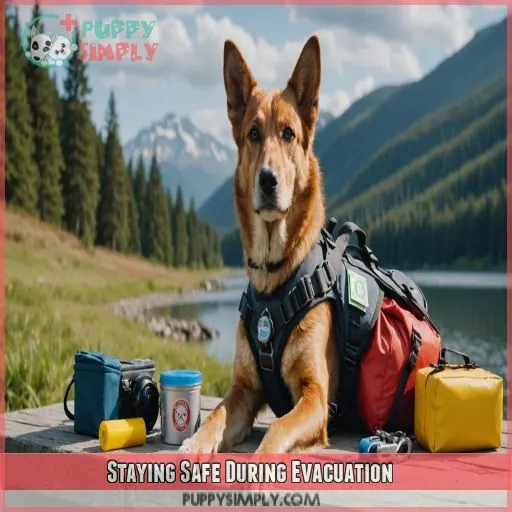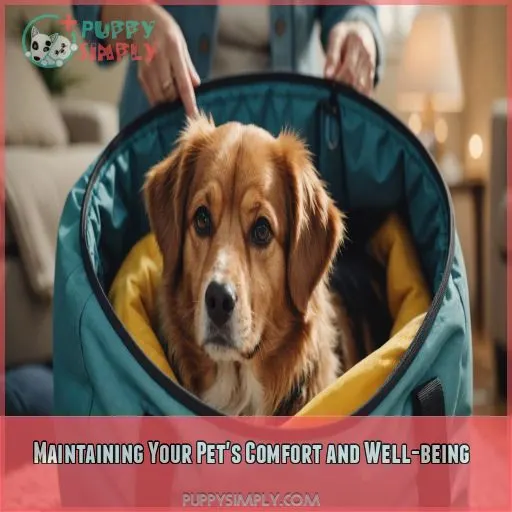This site is supported by our readers. We may earn a commission, at no cost to you, if you purchase through links.
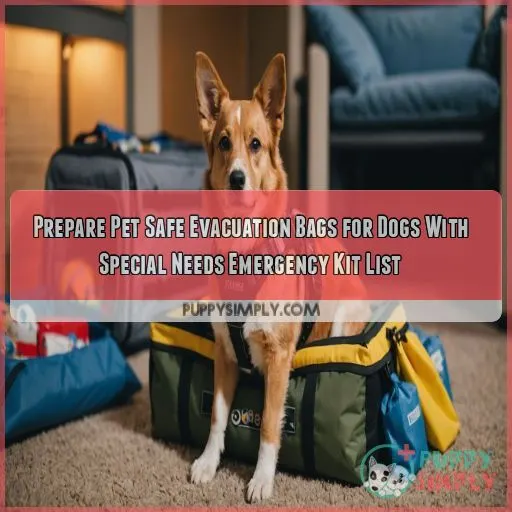
Creating a pet-safe evacuation bag specifically designed for your dog’s unique needs can be a lifesaver.
Think of it as a "grab-and-go" bag that’s packed with essentials like medication, mobility aids, and comfort items.
By having this bag ready, you’ll reduce stress and help your dog stay calm and comfortable during a chaotic evacuation.
Ready to learn how to build the paw-fect evacuation bag for your dog with special needs?
Let’s get started!
Table Of Contents
- Key Takeaways
- Creating a Pet Safe Evacuation Bag
- Building a Pet First Aid Kit
- Preparing for Emergency Situations
- Special Considerations for Dogs With Special Needs
- Staying Safe During Evacuation
- Maintaining Your Pet’s Comfort and Well-being
- Frequently Asked Questions (FAQs)
- How to make a go bag?
- What should a pet EVAC pack include?
- How to make a pet first aid kit?
- How to get a dog out of a house fire?
- What are essential supplies for dogs with medical conditions?
- How often should I update my dogs emergency kit?
- Can I use a regular backpack as an evacuation bag?
- How do I keep my dog calm during evacuation?
- What information should I include on my dogs ID tag?
- Conclusion
Key Takeaways
- You’re taking a huge step in keeping your furry friend safe by creating a pet-safe evacuation bag – kudos to you! This bag is like a superhero cape for your dog, packed with essentials like medication, mobility aids, and comfort items that’ll help them stay calm and comfortable during chaotic evacuations.
- When building this evacuation bag, you’ll want to consider your dog’s unique needs and requirements – think of it as tailoring a bespoke suit for your furry friend. From medications and medical records to sanitation supplies and comfort items, every detail matters in keeping your dog safe and happy.
- Don’t forget to prioritize your dog’s emotional well-being during evacuations – after all, a calm pup is a happier, healthier pup! Pack familiar comforts like favorite toys or blankets, and consider calming techniques like pheromone diffusers or soothing music to ease their stress and anxiety.
- Lastly, remember to regularly update and maintain your pet-safe evacuation bag to ensure it remains a reliable lifeline for your dog. Check expiration dates, store it in an easily accessible location, and adjust contents with weather changes – your furry friend’s safety depends on it!
Creating a Pet Safe Evacuation Bag
As a pet owner, creating a pet safe evacuation bag is a really important step in making sure your dog’s safety and well-being during emergencies, especially if they’ve special needs . By preparing a customized evacuation bag with essential items, you can help minimize stress and make sure a smooth evacuation process for both you and your furry friend .
Essential Items for Dogs With Special Needs
When creating a pet safe evacuation bag for dogs with special needs, consider their unique requirements. You want to make sure your furry friend stays safe and comfortable during emergencies. Here are some essentials to include:
- Medication needs and dosage instructions
- Mobility aids, such as a harness or sling
- Sensory support items, like a calming vest
- Dietary requirements, including special food and treats
- Emergency contact info, like your vet’s phone number
Choosing the Right Bag and Supplies
Choosing the right bag is super important! Consider your dog’s size, carrier type, and weight limits. Opt for durable, comfy materials with features like padding and ventilation. Think backpack-style or duffel bags with sturdy straps. Your pet’s emergency kit should be both functional and cozy – after all, it’s their lifeline!
Customizing for Your Dog’s Specific Needs
Now that you’ve chosen the right bag and supplies, it’s time to customize for your dog’s specific needs. Think about their medication needs, dietary requirements, mobility aids, and behavioral considerations. Here are four essentials to include:
- Medication and supplements: Pack enough for at least three days.
- Special dietary needs: Include food, treats, and a water filter.
- Mobility aids: Add a harness, sling, or wheelchair if needed.
- Behavioral comfort items: Pack favorite toys or calming aids.
Tips for Regularly Updating and Maintaining the Bag
Now that you’ve customized your pet safe evacuation bag, it’s important to regularly update and maintain it. Check expiration dates, store it in an easily accessible location, and adjust contents with weather changes. Don’t forget cleaning supplies and a first aid check to make sure your dog’s safety and emergency preparedness are in top shape.
Building a Pet First Aid Kit
As you prepare a pet-safe evacuation bag for your dog with special needs, don’t forget to build a pet first aid kit.
This kit should be made specifically for their unique requirements.
With a well-stocked kit, you’ll be better equipped to handle any medical emergencies that may arise during an evacuation.
You’ll be able to provide your furry friend with the care they need to stay safe and comfortable.
Must-Have Items for Dogs With Special Needs
When building a pet first aid kit for dogs with special needs, don’t forget these must-haves:
- Medications and prescriptions, with dosage instructions
- Adaptive gear, like orthopedic supports or wheelchairs
- Comfort items, such as favorite toys or blankets, to reduce stress and anxiety in emergency situations.
Creating a DIY First Aid Kit
Let’s get started on that DIY first aid kit for your furry friend! Include essentials like bandages, antiseptic wipes, and a digital thermometer. Store it in an easy-to-grab spot, and check expiration dates regularly. Don’t forget to add your vet’s contact info – just in case!
Understanding Basic First Aid Techniques
When disaster strikes, knowing pet first aid basics can be a lifesaver. Learn bleeding control, wound care, shock treatment, and CPR for dogs. Practice these skills to stay calm and act fast. With a pet safe evacuation bag and these basics, you’ll be prepared to help your furry friend.
When to Seek Veterinary Care
Don’t hesitate to seek veterinary care if your dog shows severe symptoms, unusual behavior, or ongoing issues. If you’re unsure, err on the side of caution and head to an emergency vet visit or urgent care. Your furry friend’s safety is worth it.
- Severe symptoms: Difficulty breathing, seizures, or severe injuries.
- Unusual behavior: Whining, panting, or restlessness that’s out of character.
- Ongoing issues: Persistent vomiting, diarrhea, or lethargy.
- Emergency situations: Natural disasters, accidents, or sudden illness.
Preparing for Emergency Situations
As a pet owner, preparing for emergency situations can be overwhelming, but having a solid plan in place can be a lifesaver – literally. By creating a disaster preparedness plan with your pet in mind, identifying safe zones and evacuation routes, and practicing communication and training, you’ll be better equipped to handle unexpected situations and keep your furry friend safe.
Disaster Preparedness Plan With Pets
Let’s face it, disaster preparedness isn’t exactly a fun topic, but having a solid plan in place can be a lifesaver – literally! Make sure you have a pet-friendly shelter lined up, invest in pet insurance, and prioritize emergency training to make sure your furry friend is safe during chaos.
Identifying Safe Zones and Evacuation Routes
When disaster strikes, every second counts. Identify safe zones and evacuation routes in your neighborhood by studying maps and community resources. Know the nearest pet-friendly shelters and plan a safe route to get there. Stay prepared, stay calm, and prioritize your pet’s comfort and safety above all.
Communication and Contact Information
When disaster strikes, clear communication is key. Make sure you have essential contact information at your fingertips. Keep a list of emergency contacts, vet records, and microchip info handy. Don’t get caught off guard – stay connected and in control.
Here are three must-haves for your emergency contact list:
- Vet contact info: Your vet’s phone number, email, and physical address.
- Emergency contact numbers: Friends, family, or a pet-sitter who can care for your dog.
- Microchip info: Your dog’s microchip ID and the manufacturer’s contact details.
Training and Preparation for Emergency Situations
You’ve got your Emergency Kit and evacuation bag ready, but are you prepared to use them? Practice makes perfect! Conduct regular emergency drills with your dog to make sure a smooth evacuation happens. Know your disaster plan, evacuation routes, and shelter options. Stay calm, and your dog will too!
| Emergency Situation | Preparation Tips | Pet First Aid |
|---|---|---|
| Fire | Identify escape routes, practice evacuation | Burns: cool with water, cover with bandage |
| Flood | Know shelter locations, have flotation devices | Drowning: CPR, seek medical help |
| Earthquake | Secure heavy objects, have a safe room | Injuries: apply pressure, stabilize |
| Hurricane | Board up windows, have a backup plan | Lacerations: clean, apply antibiotic ointment |
| Power Outage | Have flashlights, battery-powered radio | Heatstroke: cool, provide water |
Special Considerations for Dogs With Special Needs
As a pet owner, you know that being prepared for emergencies is really important, especially when your furry friend has special needs. In this section, you’ll learn how to tailor your pet evacuation bag to meet the unique requirements of your dog, from medications and medical records to sanitation supplies and comfort items.
Medications and Medical Records
As you prepare for emergency situations, don’t forget your dog’s medications and medical records. Store them in a waterproof container, and organize records in an easily accessible folder. Include a list of emergency meds, your vet’s contact info, and a medication safety guide to make sure your dog’s needs are met.
Sanitation Supplies and Hygiene
Having the right sanitation supplies and hygiene items on hand is really important for dogs with special needs. Don’t get caught off guard – pack these essentials in your pet’s evacuation bag:
- Poop bags: For doggy cleanup and waste disposal.
- Hand sanitizer: For when soap and water aren’t available.
- Grooming wipes: For gentle cleaning.
- Odor eliminator: For, ahem, accidents.
Carrier or Crate Considerations
When choosing a carrier or crate for your dog with special needs, consider size, weight, ventilation, security, and comfort. You want your furry friend to feel safe and relaxed during an emergency evacuation. Opt for a sturdy, well-ventilated carrier that’s easy to carry and provides ample space for your dog.
Additional Helpful Items for Dogs With Special Needs
As you pack for your dog with special needs, don’t forget mobility aids, diaper supplies, medicated shampoo, cooling vests, and special treats. Consider your dog’s unique requirements and prioritize their comfort. These extra items can make a huge difference in keeping your furry friend safe and happy during emergencies.
Staying Safe During Evacuation
When preparing for emergency situations with your dog with special needs, it’s really important to prioritize their safety during evacuation.
You can minimize risks and keep your furry friend safe and comfortable by taking a few simple steps.
These steps include having a secure leash, collar, and ID tags, ensuring carrier or crate safety, and planning for vehicle safety and temporary accommodations.
Leash, Collar, and ID Tags
When evacuating with your dog, don’t forget the essentials: leash, collar, and ID tags. Make sure your dog’s collar fits comfortably and securely. Consider microchipping for added safety. Here are must-haves:
- A well-fitting collar with identification tags
- A leash for safe walking
- Microchip information
- Personalized ID tags
- Recent photos of your dog
Carrier or Crate Safety
Now that you’ve got your dog’s leash, collar, and ID tags sorted, it’s time to think about carrier or crate safety. Choose a carrier that’s the right size for your dog, and consider crate training to reduce travel anxiety. Make sure there’s good ventilation and secure it to prevent escape attempts.
Vehicle Safety and Preparation
Now that you’ve got your carrier or crate safety covered, let’s talk vehicle safety and preparation. Make sure your vehicle is dog-ready with these essentials:
- A dog car harness or carrier to prevent distractions while driving
- A vehicle checklist to guarantee all emergency supplies are on board
- A pet-friendly roadside emergency kit
Temporary Accommodations and Pet-Friendly Shelters
When disaster strikes, you’ll want a safe haven for your furry friend. Research local pet-friendly shelters and temporary accommodations beforehand. Here’s a handy comparison table:
| Shelter | Cost | Pet Restrictions | Services |
|---|---|---|---|
| Local Shelter | Free | Limited space | Food, water, medical care |
| Pet Hotel | $20/night | None | Food, playtime, grooming |
| Airbnb | $30/night | Varies | Kitchen, laundry, pet-friendly |
| Animal Rescue | Free | Limited space | Medical care, adoption services |
| Friends/Family | Free | None | Home comforts, love |
Stay prepared, stay safe!
Maintaining Your Pet’s Comfort and Well-being
As you prepare your pet safe evacuation bag, don’t forget to prioritize your dog’s comfort and well-being – after all, a calm pup is a happier, healthier pup. By packing a few familiar comforts, nutritious snacks, and emotional support tools, you can help minimize your dog’s stress and anxiety during an emergency evacuation.
Comfort Items and Familiar Objects
When evacuating, comfort items can be a lifesaver for dogs with special needs. Pack familiar objects like favorite toys, blankets, or bedding to provide reassurance. Consider calming techniques like pheromone diffusers or calming scents to reduce stress. Include safe toys to keep your dog occupied during travel.
Food, Water, and Nutrition
As you prepare your pet safe evacuation bag, remember to pack essentials that cater to your dog’s food sensitivities, nutritional needs, and special diets. Don’t forget water access and emergency rations. Here are some must-haves:
- Canned dog food or ready-to-eat meals
- A portable water container (Source)
- A manual can opener
- Collapsible bowls for food and water (Source)
- A list of your dog’s dietary restrictions and allergies (Source)
Providing Emotional Support and Comfort
As you prioritize your dog’s physical needs, don’t forget emotional support. Include comfort objects like favorite toys or blankets in their evacuation bag. Familiar scents can be calming, so add a familiar-smelling item like a worn t-shirt. Positive reinforcement and affection can also go a long way.
Managing Stress and Anxiety in Dogs With Special Needs
When disaster strikes, managing your dog’s stress and anxiety is really important. As a pet parent, you know your furry friend’s quirks and fears. Be prepared to ease their worries with calming techniques and by recognizing anxiety triggers, such as separation anxiety, sensory overload, and behavioral changes.
- Use familiar comfort items like blankets and toys
- Create a soothing environment with pheromone diffusers or calming music
- Desensitize your dog to loud noises and crowds
- Exercise and play to reduce stress and anxiety
- Consider calming aids like treats or supplements, under veterinary guidance
Frequently Asked Questions (FAQs)
How to make a go bag?
Let’s get prepared, not panicked! Creating a go bag is a breeze – simply gather essentials like food, water, medication, and comfort items, and stash them in an easy-to-grab bag, so you’re ready to roll in no time!
What should a pet EVAC pack include?
Creating a pet EVAC pack? You’ll want to include essentials like food, water, medication, a leash, and your pet’s favorite comfort items, as well as a first-aid kit and important contact info – don’t forget a recent photo!
How to make a pet first aid kit?
Creating a pet first aid kit is a breeze! Simply gather essentials like bandages, antiseptic wipes, tweezers, and a digital thermometer, and store them in a waterproof container – your furry friend will thank you!
How to get a dog out of a house fire?
If your house catches fire, stay calm! Get your dog’s leash and emergency kit, then quickly and safely exit. Don’t use elevators, and keep low to the ground to avoid smoke inhalation – every second counts!
What are essential supplies for dogs with medical conditions?
Did you know 1 in 5 dogs has a chronic health issue? If your furry friend has a medical condition, essential supplies include a pet first-aid kit, medication, and specific medical equipment recommended by your veterinarian.
How often should I update my dogs emergency kit?
Update your dog’s emergency kit every 6-12 months to make sure everything’s still usable and not expired. Check food, water, medications, and supplies – your furry friend’s safety depends on it!
Can I use a regular backpack as an evacuation bag?
Oh, great idea, using your old college backpack as an evacuation bag! Just kidding, sort of. While it’s better than nothing, consider a sturdy, waterproof bag with easy-to-clean surfaces to keep your dog’s essentials safe and dry.
How do I keep my dog calm during evacuation?
During an evacuation, speak soothingly to your dog, maintain a calm demeanor, and provide familiar comfort items like favorite toys or blankets to help reduce their stress and anxiety.
What information should I include on my dogs ID tag?
Think of your dog’s ID tag as a superhero cape – it saves the day with important info! Include your dog’s name, your phone number, and any urgent medical needs, so they can get the help they need in a flash.
Conclusion
Life throws curveballs, and you want to be ready for anything, especially when it comes to your furry friend.
Having a pet-safe evacuation bag for dogs with special needs can be the difference between panic and peace of mind.

